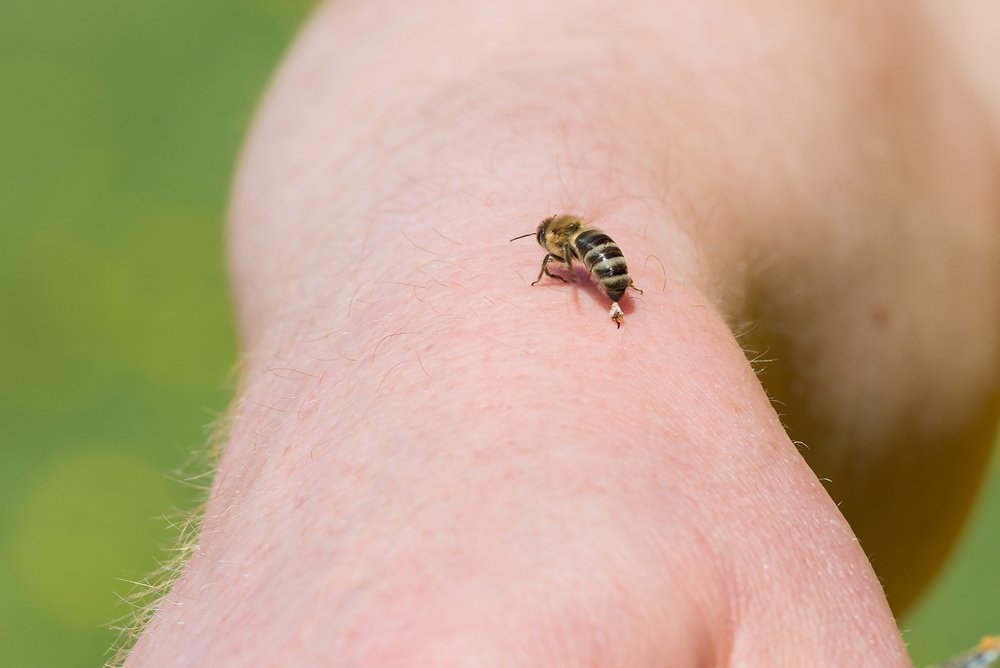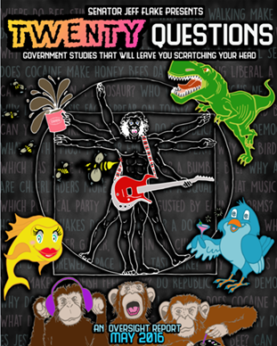5 Strange but True Scientific Studies Involving Bees
Bees aren’t just great at pollinating and making honey. Turns out they make great guinea pigs too.
5 Strange but True Scientific Studies Involving Bees
Bees aren’t just great at pollinating and making honey. Turns out they make great guinea pigs too.

Every so often members of Congress love to trot out examples of what they feel is wasteful government spending (almost exclusively from the arts, humanities, and sciences) and hold them up for ridicule. Hey, we understand. It’s much easier to make fun of something than actually take the time to understand the reasoning behind it.
The latest politically-motivated media opp of this sort happened in May when U.S. Senator Jeff Flake (R-Ariz.) issued an oversight report called “Twenty Questions: Government studies that will leave you scratching your head” that featured the kind of flashy cover art more often found on a comic book than a government report. One of the scientific studies lambasted by the Senator was on the creation of a honeybee sting pain index by Cornell graduate student Michael L. Smith. But like the following four other scientific studies involving bees, even seemingly strange research can pave the way for breakthroughs in a variety of fields and spur innovation.

Better Him Than Us
Smith stung himself with honeybees on 25 different locations on his body to determine the differing pain levels. The 2014 study, “Honey bee sting pain index by body location,” determined location-based pain perception isn’t necessarily consistent with places on the body with the thinnest skin or that have the most sensory neurons, which could be useful in studying how and why we perceive pain as we do. Smith’s work built upon the research of Justin Schmidt, a biologist, research director of the Southwest Biological Institute, and creator of the Schmidt Sting Pain Index, which measures the painfulness of various insect stings. The most painful places to be stung, according to the study, were inside the nostril, the upper lip, and penis shaft. The skull, middle toe tip, and upper arm were the least painful spots.

Bees on Blow
Building on a 2009 study by the University of Illinois at Urbana-Champaign on how cocaine effects honeybees, researchers from Macquarie University, in Sydney, Australia, and Washington University in St. Louis, examined whether honeybees developed a preference for a location where they received cocaine and whether the drug affected their foraging activities, among other behaviors. The 2014 study, “Cocaine affects foraging behaviour and biogenic amine modulated behavioural reflexes in honey bees” published on PeerJ, found cocaine does indeed affect these behaviors. Coked-up bees showed a preference for a feeding location and upped their number of visits at a sucrose feeder. The researchers determined that cocaine alters reward responses across divergent animal groups with the possibility that invertebrates, like the honeybee, could be used to study the behavioral impacts of cocaine, and possibly other drugs abused by humans.
Caffeine Puts the Buzz in Bees
In another study involving giving bees stimulants, researchers from the University of Sussex trained two groups of bees to go to two different feeders, one containing caffeine in the same amount found in many flowers. The results were similar to the behavior exhibited by bees on cocaine: caffeinated bees visited the feeder more often than the other bees. The caffeine also affected the bees’ perception of the quality of the nectar (coked-up bees had the same problem in a 2009 study). The 2015 study, “Caffeinated Forage Tricks Honeybees into Increasing Foraging and Recruitment Behaviors,” in Current Biology, found the relationship between the flowers with caffeinated nectar and bees was exploitative rather than mutually beneficial since caffeine led to behavioral changes that served the plants’ needs, but made bee colonies less productive.
They Must Be Huge AC/DC Fans
A 2015 joint study by the Royal Melbourne Institute of Technology, University of Adelaide, Harvard University, and University of California, Davis compared the pollination techniques of Australian native blue banded bees with the North American bumblebee. While the bumblebee, which is used for commercially pollinating tomato plants, grabs onto the part of the stamen that contains the pollen on tomato flowers and shakes out the pollen, their Aussie counterparts were found to bang their heads against the flowers up to 350 times a second resulting in pollen bursting into the air. By recording the audio frequency and duration of the bees’ buzz, the researchers were able to determine that the Aussie bee vibrates the flowers at a higher frequency than the bumblebee and spends less time at each flower. According to the researchers, the discovery could help improve the efficiency of crop pollination, and even has the potential to impact our understanding of muscular stress and help in the development in miniaturized flying robots.
Bees Can Be Negative Nellies, Just Like Us
When we have negative feelings, we have a tendency to exaggerate the likelihood that negative things will happen to us. Research showed that rats and dogs, as well as birds, displayed a similar tendency. But researchers from Newcastle University, in England, wanted to see if the same held true for invertebrates. They trained honeybees to associate a certain smell with a positive reward and a second smell with a punishment. When they agitated the bees by shaking them, simulating a predatory attack, the bees treated a third, neutral stimulus, as a punishment. The 2011 study that appeared in Current Biology suggested for the first time that bees can be regarded as exhibiting emotions, according to the researchers.
Don’t miss more stories from #beeweek! »
Follow us
This work is licensed under a Creative Commons Attribution-NoDerivatives 4.0 International License.
Want to republish a Modern Farmer story?
We are happy for Modern Farmer stories to be shared, and encourage you to republish our articles for your audience. When doing so, we ask that you follow these guidelines:
Please credit us and our writers
For the author byline, please use “Author Name, Modern Farmer.” At the top of our stories, if on the web, please include this text and link: “This story was originally published by Modern Farmer.”
Please make sure to include a link back to either our home page or the article URL.
At the bottom of the story, please include the following text:
“Modern Farmer is a nonprofit initiative dedicated to raising awareness and catalyzing action at the intersection of food, agriculture, and society. Read more at <link>Modern Farmer</link>.”
Use our widget
We’d like to be able to track our stories, so we ask that if you republish our content, you do so using our widget (located on the left hand side of the article). The HTML code has a built-in tracker that tells us the data and domain where the story was published, as well as view counts.
Check the image requirements
It’s your responsibility to confirm you're licensed to republish images in our articles. Some images, such as those from commercial providers, don't allow their images to be republished without permission or payment. Copyright terms are generally listed in the image caption and attribution. You are welcome to omit our images or substitute with your own. Charts and interactive graphics follow the same rules.
Don’t change too much. Or, ask us first.
Articles must be republished in their entirety. It’s okay to change references to time (“today” to “yesterday”) or location (“Iowa City, IA” to “here”). But please keep everything else the same.
If you feel strongly that a more material edit needs to be made, get in touch with us at [email protected]. We’re happy to discuss it with the original author, but we must have prior approval for changes before publication.
Special cases
Extracts. You may run the first few lines or paragraphs of the article and then say: “Read the full article at Modern Farmer” with a link back to the original article.
Quotes. You may quote authors provided you include a link back to the article URL.
Translations. These require writer approval. To inquire about translation of a Modern Farmer article, contact us at [email protected]
Signed consent / copyright release forms. These are not required, provided you are following these guidelines.
Print. Articles can be republished in print under these same rules, with the exception that you do not need to include the links.
Tag us
When sharing the story on social media, please tag us using the following: - Twitter (@ModFarm) - Facebook (@ModernFarmerMedia) - Instagram (@modfarm)
Use our content respectfully
Modern Farmer is a nonprofit and as such we share our content for free and in good faith in order to reach new audiences. Respectfully,
No selling ads against our stories. It’s okay to put our stories on pages with ads.
Don’t republish our material wholesale, or automatically; you need to select stories to be republished individually.
You have no rights to sell, license, syndicate, or otherwise represent yourself as the authorized owner of our material to any third parties. This means that you cannot actively publish or submit our work for syndication to third party platforms or apps like Apple News or Google News. We understand that publishers cannot fully control when certain third parties automatically summarize or crawl content from publishers’ own sites.
Keep in touch
We want to hear from you if you love Modern Farmer content, have a collaboration idea, or anything else to share. As a nonprofit outlet, we work in service of our community and are always open to comments, feedback, and ideas. Contact us at [email protected].by Andrew Amelinckx, Modern Farmer
June 17, 2016
Modern Farmer Weekly
Solutions Hub
Innovations, ideas and inspiration. Actionable solutions for a resilient food system.
ExploreExplore other topics
Share With Us
We want to hear from Modern Farmer readers who have thoughtful commentary, actionable solutions, or helpful ideas to share.
SubmitNecessary cookies are absolutely essential for the website to function properly. This category only includes cookies that ensures basic functionalities and security features of the website. These cookies do not store any personal information.
Any cookies that may not be particularly necessary for the website to function and are used specifically to collect user personal data via analytics, ads, other embedded contents are termed as non-necessary cookies.